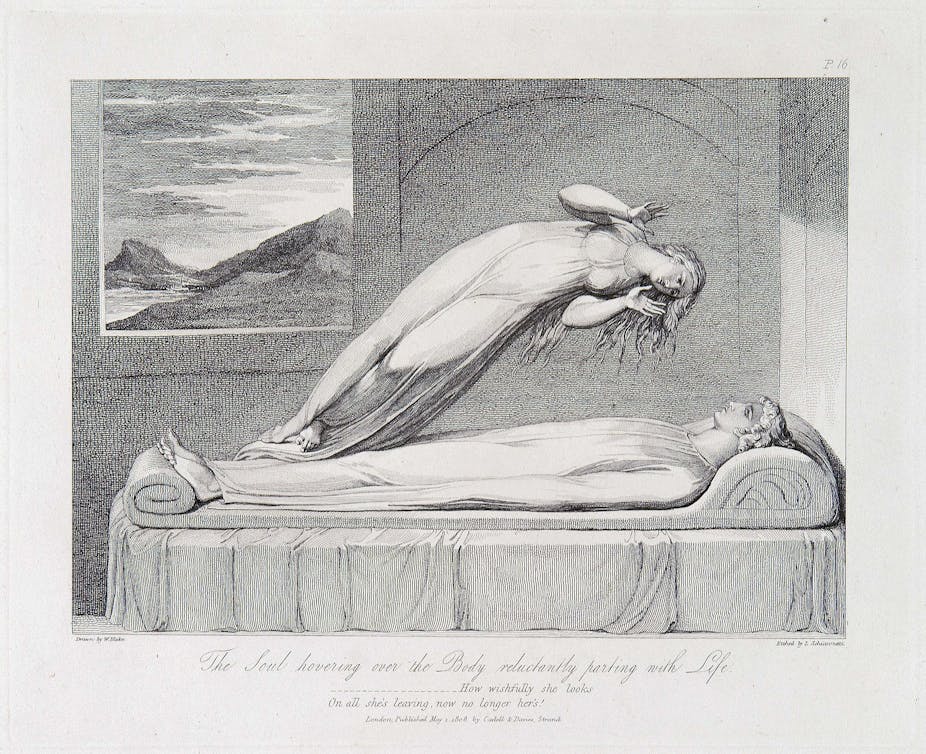In 1901, one of the most famous metaphysical experiments of the 20th century was performed by a Massachusetts physician. His name was Duncan MacDougall, and he believed that, if the soul were real, it should have measurable weight. He therefore attempted to compare the weights of patients before and after death. After testing six patients dying of tuberculosis, he concluded that dying results in the small but measurable loss of ¾ of an ounce – the weight of the soul.
To MacDougall’s way of thinking, the soul should be found only in human beings and not in other animals. He therefore performed similar measurements in dogs and found no loss in weight as the animals expired. This he regarded as confirmation of his belief that souls are found only in living human beings, and that when a human being dies, the soul leaves the body.
MacDougall’s investigations were flawed at many levels.
When his results were first published, critics argued that the weight loss could be explained by physiologic factors, such as evaporation. Moreover, his report failed to mention several patients in whom he found no weight loss. Finally, subsequent attempts to reproduce his results failed to find any weight loss. Indeed, MacDougall’s vision may have been clouded by confirmation bias, the tendency for investigators to see what they expect.
As a radiologist, I look at the interior of the human body every day, but have yet to see a soul. That does not mean it doesn’t exist. Taking the fact we cannot locate the soul on a CT or MRI scan as proof that it does not exist is as problematic as suggesting that the flaws in MacDougall’s experiment disprove the existence of the soul. Indeed, seeking physical evidence to prove the existence of the soul flies in the face of a great deal of philosophical and theological scholarship.
How the ancient Greeks viewed the soul
The ancient Greeks understood the soul as something insubstantial. They used the same word for both breath and soul, and they understood both to be intimately bound up with life.
This linkage is preserved in our usage of the term “expiration” for both breathing out and dying – in both cases, the breath or soul leaves the body. The same linkage is apparent in the Bible, where the spirit is said to move like the wind, unseen but with unmistakable effects.
Plato and Socrates appear to have regarded the soul as the essence of a living thing, including each human being. Both supposed that the soul and the body could be separated, and that the soul could carry on even after the body ceased to exist. Aristotle regarded the soul as essential to understanding the body.

In fact, Aristotle thought different kinds of living beings have different kinds of souls. A plant has a purely nutritive soul, which is responsible for growth and reproduction. An animal also has an appetitive soul, meaning that it seeks out what it needs. A human being, he thought, also has a rational soul, which gives us the desire to understand the natures of things, including souls. Following the lead of his teachers Socrates and Plato, Aristotle may have regarded this part of the soul as eternal.
Thomas Aquinas took Aristotle’s arguments even further, holding that the soul must be insubstantial because it is able to know – and thus to take the form of – every other kind of thing, whether substantial or not. For the same reason, he argued that since the soul is not made of matter, it is impervious to injury by physical forces. This in turn leads him to argue that the soul is immortal and eternal, never coming into being or passing away.
Those inclined to the materialist position – which denies reality to anything devoid of weight – would be well-advised to examine the arguments of Aristotle and Thomas Aquinas very seriously. Physical properties such as weight, color, size, location and velocity do not characterize everything we regard as real. For example, these very ideas themselves exhibit none of these properties, but who would say that they are therefore unreal?
Physicality isn’t a requirement for ‘realness’
We recognize as fully real many things that completely lack physicality.
Mathematics, for example, clearly provides deep insights into the nature of reality, but the ideas of number and quantity cannot be grasped in anyone’s hand. The same might be said for a variety of human emotions, including despair and joy, neither of which alters a person’s weight to the slightest degree. The very desire to know in the first place cannot be weighed, measured or located.
The work of these ancient and medieval thinkers offers important insights to contemporary neuroscientists, some of whom have speculated about the existence of a “God nucleus” – a brain center involved in religious faith – and that the minds of human beings are “wired” for religious belief. The structure and function of the brain may indeed offer important insights into how the mind works, but it would be a mistake, in my view, to suppose that the mind is “nothing more” than the matter of the brain.
Misguided materialists will no doubt continue trying to pin down the physical existence of the soul, but those looking at the matter from the vantage point of the greatest minds in Western civilization can understand that the effort to prove the soul’s existence through physical means is little more than a fool’s errand, like trying to prove that the number 2 is twice as big as the number 1 by weighing it.
The soul, whatever it may be, cannot be proved or disproved by natural science.

